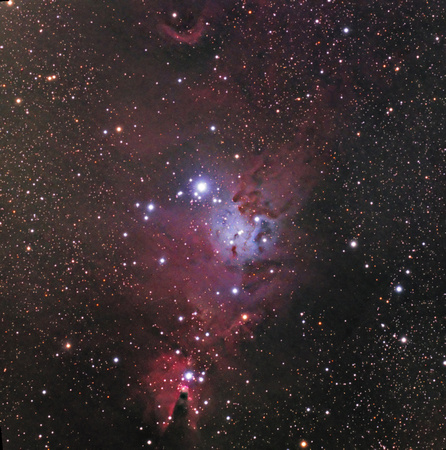SBIG ST-4000XCM
17x15minImager Temp -20CAPM/TMB 130/780Field Flattener
10% Crop for Composition
Windy Conditions, Snow Covered Ground Making for Light Skies
Link to Larger JPEGAnacortes Telescope and Wild Bird Picture of the Day January 19, 2010NGC 2264 is the designation of the nebulae and star cluster in this area which lies about 2600 light-years from Earth in
Monoceros the Unicorn. It may in fact be physically linked to the
Rosette Nebula Complex. The names given the objects in this image are the
Cone Nebula (dark cone at the bottom of the image), the Christmas Tree Cluster (upside down in this image), and the Fox Fur Nebula at the upper mid right above the
reflection nebula. The
area is very bright in
Hydrogen Alpha emission.
The Cone Nebula is a pillar of gas and dust containing an infrared source embedded in a
Bok globule at its tip. The infrared source, which appears to be a hot
B-class star about 3500 times more luminous than our Sun, is located just beyond the tip of the Cone nebula and may be creating a stellar wind that energises and shapes the nebula.
The bright star at the center of this picture is
15 Monocerotis (or 'S Monocerotis') - it is a multiple star system consisting of perhaps seven or more stars, including four brilliant blue-white stars (classes O7, B7, B8 and A6) and it is partly or totally responsible for causing the nebula to glow. This semi-regular variable star contains an extremely luminous class-O7 dwarf, that is in fact
two hot stars orbiting each other with a period of 25 years. Their masses could be perhaps 30 and 20 times solar with luminosities 125,000 and 50,000 times that of our Sun.
January 13, 2010


